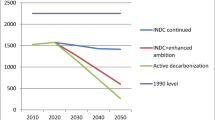Abstract—
The article discusses the conceptual foundations and methodological approaches related to regulation of the processes of decarbonization of the Russian economy in light of the implementation of the Strategy of Low Greenhouse Gas Emissions Socio-Economic Development of the Russian Federation for the period until 2050. A conceptual scheme for a regional dimension of the development of scenarios of decarbonization of the Russian economy, including its key industries—nonenergy sectors, which is especially relevant in the context of significant spatial differentiation both in terms of indicators of socio-economic development and industry structure of individual Russian regions and in terms of location of greenhouse gas-intensive industries. The proposed approach to regionalization of greenhouse gas emissions is based on determination of the regional structure of production and its technological landscape, as well as integral estimates of prospects for decarbonization in individual regions. The results can be used in the development of scenarios of decarbonization of the Russian economy and its individual industries.


Similar content being viewed by others
REFERENCES
F. Barca, An Agenda for a Reformed Cohesion Policy: A Place-Based Approach To Meeting European Union Challenges and Expectations (European Commission, Brussels, 2009).
S. Giest, “Place-based policy in climate change: Flexible and path-dependent elements,” Int. J. Public Adm. 37, 824–834 (2014). https://doi.org/10.1080/01900692.2014.917100
N. Moore-Cherry, A. Clavin, T. Krawchenko, and J. Tomaney, Exploring Place-Based Opportunities for Policy and Practice in Transition, Research Paper no. 24, National Economic & Social Development Office NESDO, 2022.
N. Balta-Ozkan, T. Watson, and E. Mocca, “Spatially uneven development and low carbon transitions: insights from urban and regional planning,” Energy Policy 85, 500–510 (2015). https://doi.org/10.1016/j.enpol.2015.05.013
T. Hansen and L. Coenen, “The geography of sustainability transitions: Review, synthesis and reflections on an emergent research field,” Environ. Innovation Soc. Transitions 17, 92–109 (2015). https://doi.org/10.1016/j.eist.2014.11.001
G. Bridge, “The map is not the territory: a sympathetic critique of energy research’s spatial turn,” Energy Res. Soc. Sci. 36, 11–20 (2018). https://doi.org/10.1016/j.erss.2017.09.033
G. Garvey, J. B. Norman, M. Büchs, and J. Barrett, “A ‘spatially just’ transition? A critical review of regional equity in decarbonisation pathways,” Energy Res. Soc. Sci. 88, 102630 (2022). https://doi.org/10.1016/j.erss.2022.102630
P. McCann and A. Rodríguez-Pose, “Why and when development policy should be place-based,” OECD Regional Outlook 2011: Building Resilient Regions for Stronger Economies (OECD , Paris, 2011). https://doi.org/10.1787/9789264120983-en/
F. Barca, P. McCann, and A. Rodríguez-Pose, “The case for regional development intervention: place-based versus place-neutral approaches,” J. Reg. Sci. 52, 134–152 (2012). https://doi.org/10.1111/j.1467-9787.2011.00756x
O. Golubchikov and K. O’Sullivan, “Energy periphery: Uneven development and the precarious geographies of low-carbon transition,” Energy Build. 211, 109818 (2020). https://doi.org/10.1016/j.enbuild.2020.109818
S. Avila, “Environmental justice and the expanding geography of wind power conflicts,” Sustainability Sci. 13, 599–616 (2018). https://doi.org/10.1007/s11625-018-0547-4
A. N. Bufetova, “Polarization of Russia’s spatial development: Whither goest thou?,” Mir Ekon. Upr. 22, 103–129 (2022). https://doi.org/10.25205/2542-0429-2022-22-1-103-129
O. M. Shatalova and E. V. Kasatkina, “Socio-economic inequality of regions in the Russian Federation: Measurement issues and long-term evaluation,” Econ. Soc. Changes: Facts, Trends, Forecast 15 (4), 74–87 (2022). https://doi.org/10.15838/esc.2022.4.82.5
E. S. Gubanova and V. S. Kleshch “Methodological aspects of the analysis of the level of uneven socio-economic development of regions,” Ekonomicheskie i Sotsial’nye Peremeny: Fakty, Tendentsii, Prognoz 10 (1), 58–75 (2017). https://doi.org/10.15838/esc/2017.1.49.4
Spatial Development of Modern Russia: Trends, Factors, Mechanisms, Institutions, Ed. by E. A. Kolomak (Inst. Ekon. Org. Prom. Proizvod. Sib. Otd. Ross. Akad. Nauk, Novosibirsk, 2020) [in Russian].
P. A. Minakir, “Spatial heterogeneity of Russia and the tasks of regional policy,” Zh. Nov. Ekon. Assots. 10 (10), 150–153 (2011).
N. M. Svetlov, R. G. Yanbykh, and D. A. Loginova, “On the heterogeneity of the effects of state support for agriculture,” Vopr. Ekon., No. 4, 59–73 (2019). https://doi.org/10.32609/0042-8736-2019-4-59-73
B. N. Porfir’ev, “On the ‘green’ vector of the strategy of socio-economic development of Russia,” Nauchn. Tr. Vol’nogo Ekon. O-va Ross. 227 (1), 128–136 (2021). https://doi.org/10.38197/2072-2060-2021-227-1-128-136
D. N. Ershov, M. V. Sigova, and I. A. Nikitina, “Reflection of the concept of energy transition in the development strategies of industries and regions of Russia,” Vestn. St. Peterb. Univ., Ekon. 39 (1), 73–101 (2023).https://doi.org/10.21638/spbu05.2023.104
National Report on the Inventory of Anthropogenic Emissions from Sources and Removals by Sinks of Greenhouse Gases Not Controlled by the Montreal Protocol for 1990–2021 (Rosgidromet, Moscow, 2023), Pt. 1 [in Russian].
I. P. Glazyrina and I. A. Zabelina, “Spatial Heterogeneity of Russia in the Light of the Concept of a Green Economy: The Social Context,” Geogr. Nat. Resour. 39, 103–110 (2018). https://doi.org/10.1134/S1875372818020026
D. A. Gainanov, R.F. Gataullin, and R. G. Safiullin, “Typology of regional systems in Russia in connection with the processes of decarbonization of the economy,” Ekon. Reg. 19 (1), 29–44 (2023). https://doi.org/10.17059/ekon.reg.2023-1-3
V. S. Tikunov and O. Yu. Chereshnya, “Pollution index and index of environmental tension in the regions of the Russian Federation,” Teor. Prikl. Ekol., No. 3, 34–38 (2017). https://doi.org/10.25750/1995-4301-2017-3-034-038
Funding
The study is part of research for the Critical Innovation Project of National Significance “Unified National Monitoring System for Climatically Active Substances” approved by the Order of the Government of the Russian Federation no. 3240-r dated October 29, 2022.
Author information
Authors and Affiliations
Corresponding author
Ethics declarations
The authors declare that they have no conflicts of interest.
Additional information
Translated by A. Ovchinnikova
Rights and permissions
About this article
Cite this article
Gilmundinov, V.M., Pankova, Y.V. & Tagaeva, T.O. The Concept of Regional Differentiation of the Processes of Decarbonization of the Russian Economy. Stud. Russ. Econ. Dev. 34, 786–793 (2023). https://doi.org/10.1134/S1075700723060059
Received:
Revised:
Accepted:
Published:
Issue Date:
DOI: https://doi.org/10.1134/S1075700723060059




